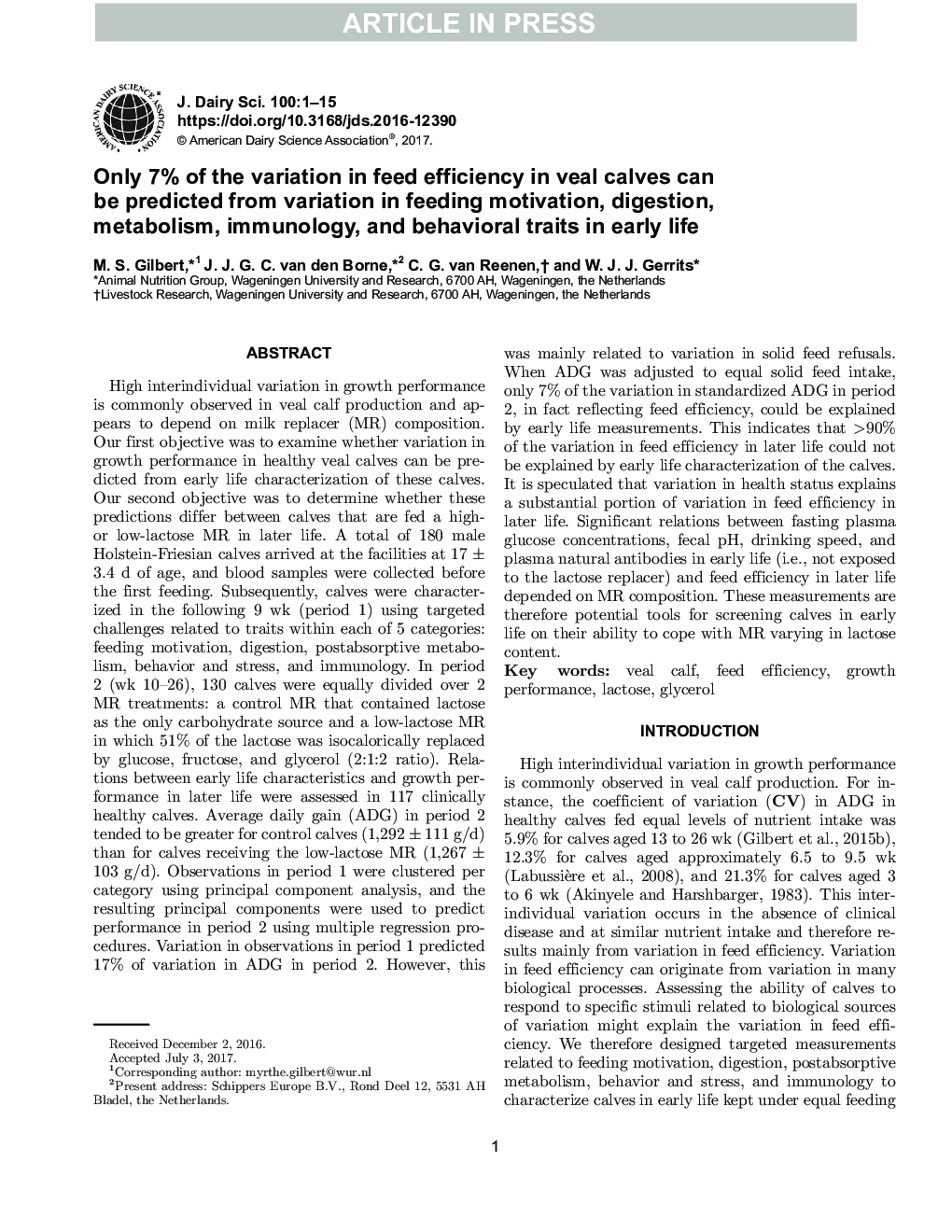| کد مقاله | کد نشریه | سال انتشار | مقاله انگلیسی | نسخه تمام متن |
|---|---|---|---|---|
| 5541996 | 1402513 | 2017 | 15 صفحه PDF | دانلود رایگان |
عنوان انگلیسی مقاله ISI
Only 7% of the variation in feed efficiency in veal calves can be predicted from variation in feeding motivation, digestion, metabolism, immunology, and behavioral traits in early life
ترجمه فارسی عنوان
فقط 7 درصد از تغییر در بازده خوراک در گوساله گوشت گوساله را می توان از تنوع در تغذیه انگیزه، هضم، متابولیسم، ایمونولوژی، و ویژگی های رفتاری در اوایل زندگی پیش بینی
دانلود مقاله + سفارش ترجمه
دانلود مقاله ISI انگلیسی
رایگان برای ایرانیان
کلمات کلیدی
گوساله گوشت گوساله، بازده خوراک، عملکرد رشد، لاکتوز، گلیسرول،
موضوعات مرتبط
علوم زیستی و بیوفناوری
علوم کشاورزی و بیولوژیک
علوم دامی و جانورشناسی
چکیده انگلیسی
High interindividual variation in growth performance is commonly observed in veal calf production and appears to depend on milk replacer (MR) composition. Our first objective was to examine whether variation in growth performance in healthy veal calves can be predicted from early life characterization of these calves. Our second objective was to determine whether these predictions differ between calves that are fed a high- or low-lactose MR in later life. A total of 180 male Holstein-Friesian calves arrived at the facilities at 17 ± 3.4 d of age, and blood samples were collected before the first feeding. Subsequently, calves were characterized in the following 9 wk (period 1) using targeted challenges related to traits within each of 5 categories: feeding motivation, digestion, postabsorptive metabolism, behavior and stress, and immunology. In period 2 (wk 10-26), 130 calves were equally divided over 2 MR treatments: a control MR that contained lactose as the only carbohydrate source and a low-lactose MR in which 51% of the lactose was isocalorically replaced by glucose, fructose, and glycerol (2:1:2 ratio). Relations between early life characteristics and growth performance in later life were assessed in 117 clinically healthy calves. Average daily gain (ADG) in period 2 tended to be greater for control calves (1,292 ± 111 g/d) than for calves receiving the low-lactose MR (1,267 ± 103 g/d). Observations in period 1 were clustered per category using principal component analysis, and the resulting principal components were used to predict performance in period 2 using multiple regression procedures. Variation in observations in period 1 predicted 17% of variation in ADG in period 2. However, this was mainly related to variation in solid feed refusals. When ADG was adjusted to equal solid feed intake, only 7% of the variation in standardized ADG in period 2, in fact reflecting feed efficiency, could be explained by early life measurements. This indicates that >90% of the variation in feed efficiency in later life could not be explained by early life characterization of the calves. It is speculated that variation in health status explains a substantial portion of variation in feed efficiency in later life. Significant relations between fasting plasma glucose concentrations, fecal pH, drinking speed, and plasma natural antibodies in early life (i.e., not exposed to the lactose replacer) and feed efficiency in later life depended on MR composition. These measurements are therefore potential tools for screening calves in early life on their ability to cope with MR varying in lactose content.
ناشر
Database: Elsevier - ScienceDirect (ساینس دایرکت)
Journal: Journal of Dairy Science - Volume 100, Issue 10, October 2017, Pages 8087-8101
Journal: Journal of Dairy Science - Volume 100, Issue 10, October 2017, Pages 8087-8101
نویسندگان
M.S. Gilbert, J.J.G.C. van den Borne, C.G. van Reenen, W.J.J. Gerrits,
